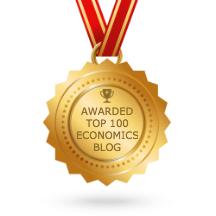See Your New Lunch Habit Is Hurting the Economy: More people are bringing lunch to work and restaurants are selling fewer lunches than they did in 2020 by Ray A. Smith of the WSJ.
I have done several posts on how people have been dealing with the
inflation of the last few years as well as how they have been affected.
Those are listed after some excerpts from the article.
"Many workers are finding picking up lunch is too pricey"
"Nationwide, the number of lunches bought from restaurants and other establishments fell 3% in 2024 from the year before"
"purchases of food from grocery and other stores that shoppers intend to eat at home or bring to work for lunch climbed 1%."
"The shift is a threat to the ecosystem of delis, cafes and other office-area eateries"
I don't think what the office workers are doing is bad for the economy (although it hurts restaurants). What was bad for the economy was high inflation and people are simply reacting to it (the inflation rate in 2021 was 7.0% and in 2022 it was 6.5%). This means less money for restaurants and more money for consumers and grocery stores. Some are better off and some are worse off. It is not clear that the economy as a whole is worse off.
Professor Mark Thoma of the University of Oregon had a post at his blog on the disagreement over what the optimal inflation rate is called Do We Need to Rethink Macroeconomic Policy? Some economists think maybe 4% would be okay. But this article gives you a good idea of the issues and controversies surrounding the unemployment-inflation tradeoff. I think this means that inflation makes it hard for businesses to make efficient decisions on buying resources. If prices are distorted you don't know the true value of things. Then it is harder to make good decisions. Excerpt:
"Just to be clear, the relative price of good A to good B is PA/PB. If there is inflation and one of the two prices is stickier than the other, then the two prices will change at different rates in response to inflation. This pushes relative prices away from their fundamental values, and this in turn distorts resource flows (which leads to losses and unemployment as resources are subsequently reallocated). The higher the inflation rate, the faster these prices become distorted and the higher the subsequent costs. This is not the only cost of inflation, but on this basis alone it's likely that at some point the costs of inflation will exceed the benefits. The hard question is where the breakpoint is (partly because we don't have good estimates of either the costs or the benefits, so it's possible to support most any position by picking and choosing among the empirical studies). I'd be very uncomfortable with a rate over 4%, 4% itself seems a bit high, but 3% isn't so hard to accept."
Related posts:
Child Care, Rent, Insurance: Where Inflation Hits Hardest Now (2024)
Why do workers dislike inflation? (2024)
"workers must take costly actions (“conflict”) to have nominal wages catch up with inflation" They have to bargain with or fight their employers to get a wage increase to match inflation.
An Increase in Uninsured Drivers Is Pushing Up Costs for Everyone Else (2024)
Inflation has caused consumers to choose what they need to cut back on (insurance)
Costco and Sam’s Club Aisles Are Full of Gen Z Shoppers (2024)
Consumers are buying in bulk to save money by getting a lower per unit price
Inflation is mentally taxing (2024)
Inflation is mentally taxing. Dealing with a straitened budget exacts a psychological toll as well as a financial one
Store Brands Are Filling Up More of Your Shopping Cart (2024)
People are on the look out for cheaper alternatives due to inflation
Consumers Fed Up With Food Costs Are Ditching Big Brands (2024)
After
years of price increases, food companies say more consumers pull back;
fast-food chains and snack makers plan new deals and flavors
Are Americans Worrying Too Much About Inflation? Two opposing views (2024)
The Era of One-Stop Grocery Shopping Is Over (2024)
One
thing that I always talked about with inflation was that one of its
costs was all the things we had to do to avoid it. Consumers are making
8% more trips to different retailers as inflation continues to upend
household budgets. They are going to more stores to find lower prices.
But it costs time to do that and probably more money on gas.
When workers were paid twice a day and given half-hour shopping breaks (Germany, 1923)
By mid-1923 workers were being paid as often as three times a day. Their wives would meet them, take the money and rush to the shops to exchange it for goods. However, by this time, more and more often, shops were empty. Storekeepers could not obtain goods or could not do business fast enough to protect their cash receipts. Farmers refused to bring produce into the city in return for worthless paper. The requirements to calculate and recalculate commercial transactions in the billions and trillions made it practically impossible to do business in paper Marks.

No comments:
Post a Comment